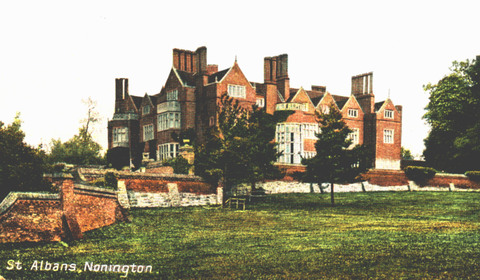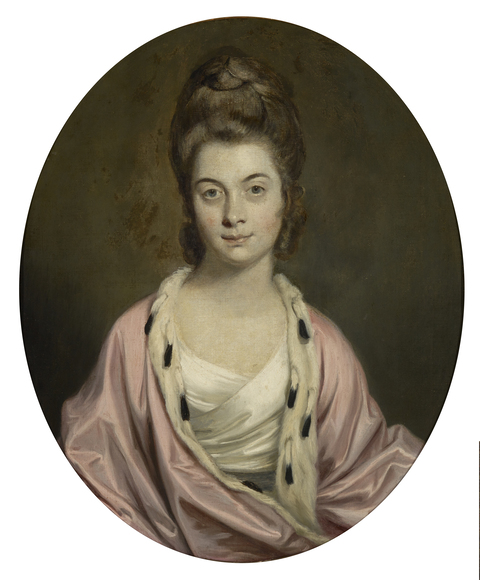Marks, Inscriptions, and Distinguishing Features
Beneath spandrel of frame, lower left, in red: “Mrs. Payler./Sir Josh. Reynolds”
Entry


Author
Provenance
Mrs. Thomas Watkinson Payler, née Charlotte Hammond (1747–1810);14
By descent within the family to Egerton Hammond, Non[n]ington, Kent, until about 1931.15
(Robert C. Vose Galleries, Boston);16
G.H.A. Clowes, Indianapolis, in 1935;17
The Clowes Fund, Indianapolis, from 1958–2015, and on long-term loan to the Indianapolis Museum of Art since 1971 (C10065);
Given to the Indianapolis Museum of Art, now the Indianapolis Museum of Art at Newfields, in 2015 (2015.29).
Exhibitions
John Herron Art Museum, Indianapolis, 1935, American and European Painting from Vose Galleries;
John Herron Art Museum, Indianapolis, 1941, Early British Masters, no. 26;
John Herron Art Museum, Indianapolis, 1959, Paintings from the Collection of George Henry Alexander Clowes: A Memorial Exhibition, no. 48;
The Art Gallery, University of Notre Dame, Notre Dame, IN, 1962, A Lenten Exhibition, no. 41;
Indiana University Art Museum, Bloomington, 1963, Northern European Painting: The Clowes Fund Collection, no. 48;
Indianapolis Museum of Art at Newfields, 2019, Life and Legacy: Portraits from the Clowes Collection.
References
Algernon Graves and William Vine Cronin, A History of the Works of Sir Joshua Reynolds, P.R.A. (London: Henry Graves and Co., 1899–1901), 2:735;
“Masters' paintings being shown here,” Indianapolis Star, 21 April 1935;
Ellis K. Waterhouse, Reynolds (London: Macmillan, 1937), 62;
Mark Roskill, “Clowes Collection Catalogue” (unpublished typed manuscript, IMA Clowes archive, Indianapolis Museum of Art, Indianapolis, IN, 1968);
A. Ian Fraser, A Catalogue of the Clowes Collection (Indianapolis: Indianapolis Museum of Art, 1973), 92–93;
David Mannings and Martin Postle, Sir Joshua Reynolds: A Complete Catalogue of His Paintings (New Haven and London: Yale University Press, 2000), 1:369, no. 1411; 2: fig. 1034 (reproduced).
Technical Notes and Condition
The painting is supported by a glue lining, which appears secure. There is evident cusping that shows the painting remains at approximately its original dimensions. The original tacking margins were trimmed slightly, presumably when it was relined. The sitter is framed by a painted oval, which may or may not have been slightly trimmed. There is a fine network of craquelure consistent with age. The paint was applied wet-in-wet, and some slight impasto is visible in the folds of the fabric, in the white and pink areas. The hair was painted in brown glazes with a few defining black lines, using medium-size brushes. Overall, the portrait is relatively thinly painted, and this is especially evident in certain places; some light surface abrasion has presumably made this more evident. There is a thinly applied brownish green ground, with the canvas weave showing through in places, and an off-white ground visible underneath the figure. No evident underdrawing can be seen with IRR; this is typical of Reynolds’s working methods. Some minor pentimenti are visible in the sitter’s hair and in the clothing folds on her proper left. Some of the pigments have been fugitive, especially in the flesh tones, which were apparently painted with lakes. The sitter’s robe remains pink and was painted using more stable vermilion pigments. There is some discolored retouching to the face and neck, as well as some recent retouching, with deliberate additions of canvas texture. The old resin varnish is discolored and has pooled in the canvas divots. The portrait is inscribed lower left, outside the painted oval, in vermilion: “Mrs. Payler. / Sir Josh. Reynolds.” The portrait of Mr. Payler is comparably inscribed lower right “Mr. Payler/Sir Josh. Reynolds.” There is a stamp on the lower stretcher bar: “R.C. Vose PAINTINGS BOSTON,” as well as a label attached to the frame, verso: “Lent Robert C. Vose Galleries/168.1930.” The painting is shown in a reproduction frame with an oval-shaped opening, of about 1900, carved oak with gilding over reddish orange bole, with decorative acanthus leaves and husk. It is a version of a French pattern of about 1745.
Notes
-
For a full account, see David Mannings and Martin Postle, Sir Joshua Reynolds: A Complete Catalogue of His Paintings (New Haven and London: Yale University Press, 2000), 1:369. ↩︎
-
Cited in Letter from W. Roberts to unknown recipient, 26 November 1931, File C10065, Clowes Registration Archive, Indianapolis Museum of Art at Newfields. St. Alban’s Court was acquired by the Hammond family in 1555 and remained in their possession until 1938, at which point the estate encompassed just more than 1,000 acres. ↩︎
-
David Mannings and Martin Postle, Sir Joshua Reynolds: A Complete Catalogue of His Paintings (New Haven and London: Yale University Press, 2000), 1:369. ↩︎
-
Letter from W. Roberts to unknown recipient, 26 November 1931, File C10065, Clowes Registration Archive, Indianapolis Museum of Art at Newfields. ↩︎
-
David Mannings and Martin Postle, Sir Joshua Reynolds: A Complete Catalogue of His Paintings (New Haven and London: Yale University Press, 2000), 1:369. ↩︎
-
Vose Gallery price list, April 1935, File C10065, Clowes Registration Archive, Indianapolis Museum of Art at Newfields. ↩︎
-
Letter from Booth Tarkington to G.H.A. Clowes, 24 April 1935, File C10065, Clowes Registration Archive, Indianapolis Museum of Art at Newfields. ↩︎
-
Invoice for Mrs. Payler by Sir Joshua Reynolds, P.R.A., 29 April 1935, File C10065, Clowes Registration Archive, Indianapolis Museum of Art at Newfields. ↩︎
-
Letter from Grace Speer on behalf of Wilbur D. Peat, Esq., to Robert Vose, 15 May 1935, File C10065, Clowes Registration Archive, Indianapolis Museum of Art at Newfields. ↩︎
-
Mark Roskill, “Clowes Collection Catalogue” (unpublished typed manuscript, IMA Clowes Archive, Indianapolis Museum of Art, Indianapolis, IN, 1968). ↩︎
-
Alexandra Gent, Ashok Roy, and Rachel Morrison, “Practice Makes Imperfect: Reynolds’s Painting Technique,” National Gallery Technical Bulletin 35 (2014): 27n97. ↩︎
-
Alexandra Gent, Ashok Roy, and Rachel Morrison, “Practice Makes Imperfect: Reynolds’s Painting Technique,” National Gallery Technical Bulletin 35 (2014): 28n106. ↩︎
-
Edmund Burke, “Character of Sir Joshua Reynolds,” Morning Chronicle, London, 25 February 1792. ↩︎
-
Pendant portraits of Mr. and Mrs. Payler were painted a few months after their marriage in January 1771; see Algernon Graves and William Vine Cronin, A History of the Works of Sir Joshua Reynolds, P.R.A. (London: Henry Graves and Co., 1899–1901), 2:735; Beneath the spandrel of the frame on the rectangular canvas at bottom left in red paint: “Mrs. Payler./Sir Josh. Reynolds;” see Technical Examination Report. ↩︎
-
Copy of certificate, signed W. Roberts, London, 26 November 1931, File 2015.29 (C10065), Conservation Department Files, Indianapolis Museum of Art at Newfields. ↩︎
-
Remnants of a label on back of frame indicate the following: “Lent Robert C. Vose Galleries/168.1930”; see Technical Examination Report. ↩︎
-
The painting was shown at the exhibition American and European Painting from Vose Galleries at the John Herron Art Institute (now Indianapolis Museum of Art) in 1935; see Archives of American Art, Vose Galleries, Box 8, Folder 4 (JHAI). These records at the Archives of American Art also include an exhibition checklist with prices, as well as a letter from JHAI to Robert C. Vose indicating that a commission was paid to JHAI when G.H.A. Clowes purchased the painting out of this exhibition. ↩︎
